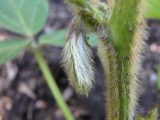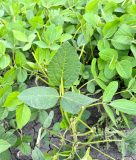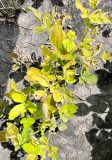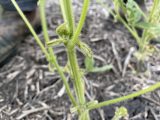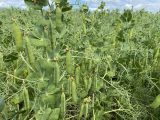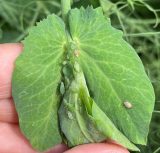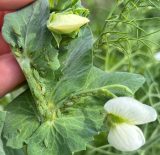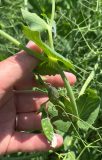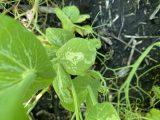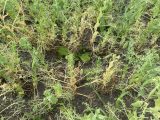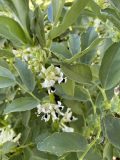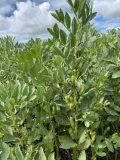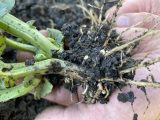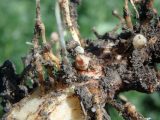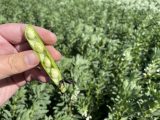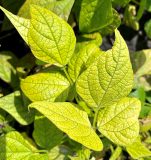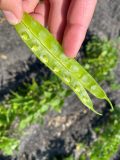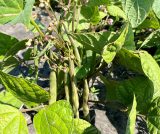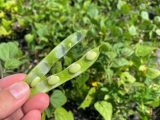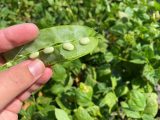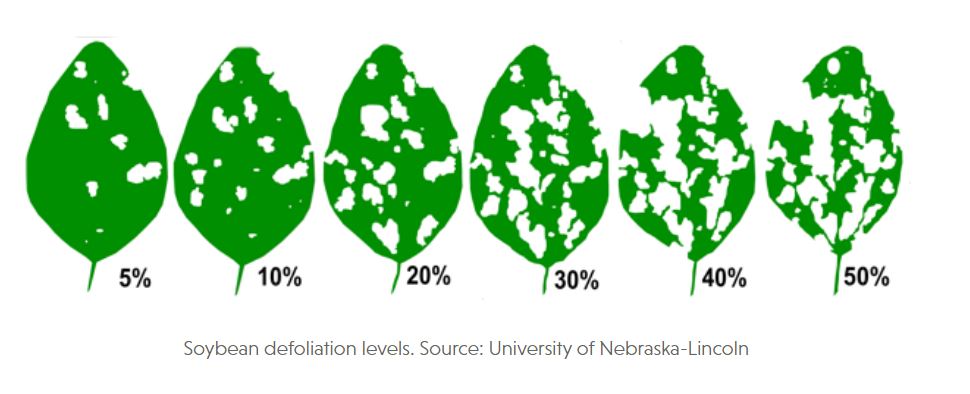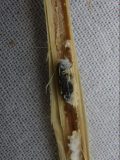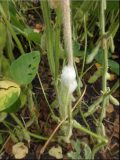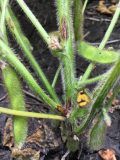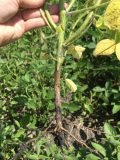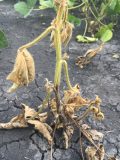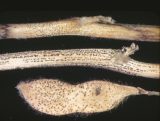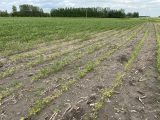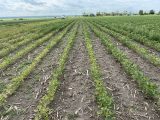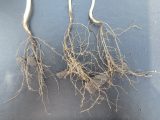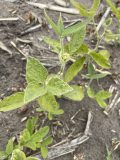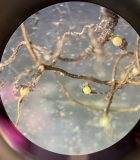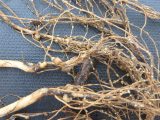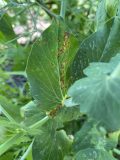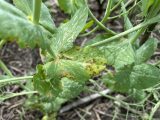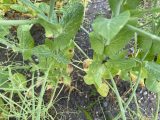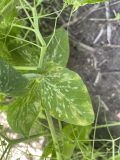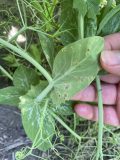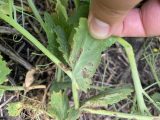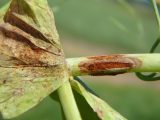 AUGUST 3, 2022
AUGUST 3, 2022
- Crop and scouting update
- Grasshopper defoliation at R stages
- Soybean stem diseases
- Phytophthora root rot
- Soybean cyst nematode
- Pea disease ID with photos from the field
- Root Rot Testing in Peas: Where to send samples to test for Aphanomyces
- Lygus bugs in faba beans
- Aphid enemies
- Field pea desiccation and harvest guide
- Upcoming Events:
- August 3: Keep it Clean Pre-Harvest Tips & Tools Webinar
- August 9: Canada-Manitoba Crop Diversification Centre (CMCDC) Field Day at Carberry.
Listen to the Bean Report:
Crop and Scouting Update
- Soybeans are setting and filling pods, staging them at R3 to R4.
- Soybean aphids have been confirmed in a few fields at low levels. These aphids blow in from the south and overall, populations remain quite low here. Natural enemies are typically able to manage aphid levels. Read the Soybean Aphids: Identification, Scouting and Management fact sheet for more information.
- Bacterial blight, Septoria brown spot and downy mildew foliar disease symptoms are present in the soybean canopy at low levels and are unlikely to affect yield.
- Field peas range from R3 (flat pod) to R4 (full pod) stages. Some of the earliest seeded fields are beginning to mature.
- Once peas have reached the full pod stages where seeds have filled the pod, fungicide applications are no longer recommended because we’re within the 30-day pre-harvest interval of several products and because disease is no longer expected to affect yield. Also, once peas have reached full pod, they are not as sensitive to pea aphid feeding and control is no longer necessary.
- For later-seeded peas that are just entering early podding stages, now is the time to check for pea aphids and second fungicide applications. Pea aphids have been a problem in several fields this year.
- Dry beans range from R3 to R5, forming pods that are an inch or more long to beginning to fill seed. Continue to scout and assess the risk of white mold development.
- Faba beans are at full pod with some foliar diseases beginning to show up.
Grasshopper defoliation at R stages
Grasshopper development and damage is continuing to be reported in fields across Manitoba. There may be lots of grasshoppers jumping around, but of the 85 grasshopper species in Manitoba, only four have the potential to become crop pests including the migratory, twostriped, clearwinged and packard grasshoppers.
Thresholds and tips for control:
- Soybeans and dry beans are at reproductive staging and thresholds are lower than during vegetative growth. The defoliation threshold from bloom to pod fill is 15% and from pod fill to maturity is 25%. Unless pod feeding is observed, low levels of defoliation will not cause economical yield loss.
- Grasshopper populations are typically concentrated along roadsides and field edges, so a border spray may be all that is needed.
- The best time to control grasshoppers is after most have hatched and before most have turned into adults. As of July 20 (Manitoba Crop and Pest Report), grasshopper adults were observed, although a range of stages can still be found. Grasshoppers can still be controlled at the adult stage, but it becomes more difficult, as they can fly and disperse more easily, and some insecticides do not work as well on adults. Higher rates of insecticide may be needed at the adult stage, meaning control also becomes more expensive.
Consider beneficial insects in your grasshopper management decisions. Ground beetles, crickets, larvae of blister beetles and bee flies are all predators that feed on grasshopper eggs. Those that feed on eggs don’t offer much help now though since we’re controlling adults. Spiders, robber flies, some wasps, and different types of birds and rodents will feed on grasshopper nymphs and adults. There are also parasitoids and pathogens that can help control grasshopper populations. Also consider pollinators that might be present. If a crop must be sprayed at the flowering stage, apply as late in the day as possible and choose an insecticide that is not harmful to pollinators (e.g., Coragen).
Soybean Stem Diseases

Stem diseases generally have a greater impact on yield than foliar diseases and are more common to find in August. In recent disease surveys, stem disease prevalence and incidence has been low with previous dry growing seasons. Northern stem canker and white mould are the most common stem diseases found in soybeans. Northern stem canker is relatively new to Manitoba, and has become more common with more soybean growing history in Manitoba.
- White mould: infections begin at nodes along the main stem. Wilted plants may be spotted from afar, within a humid canopy you may find white mycelial growth and black sclerotia bodies later in the season. Cool, wet conditions throughout July and August favour white mould development.
- Northern stem canker: small, reddish-brown lesions at the base of a branch or petiole in the lower third of the canopy after flowering. Lesions expand to form sunken cankers with reddish margins. May be confused with Phytophthora root and stem rot.
- Phytophthora root and stem rot: late infection appears as a chocolate brown lesion on the stem that extends upwards from the soil line. If roots are rotten, suspect PRR. If roots appear healthy, northern stem canker may be suspected.
- Pod and stem blight: distinct lines of raised, black dots on infected stems and pods.
- Anthracnose: reddish-brown, irregularly-shaped blotches on leaves and stems. Black fungal bodies develop in these blotches later in the season.
Phytophthora Root Rot (PRR)
- Phytophthora root rot is a root and stem disease specific to soybeans that can infect at any growth stage.
- Symptoms appear as brown lesions that extend upwards from the soil line, and roots are discolored and unhealthy. Plants will be wilted and leaves remain attached to the plant. Infection occurs in patches or as randomly-infected plants.
- One look-alike to PRR is Northern Stem Canker where plants will appear wilted and there will be a brown lesion along the stem. But with stem canker, roots will appear healthy and the lesion won’t extend upwards from the soil line.
- The best strategy to manage Phytophthora is crop rotation. A four-year break between soybean crops will help break up the pathogen’s life cycle.
- The next best strategy is variety resistance, of which there are two types:
- Race-specific or major gene resistance: a resistance gene is completely resistant to specific pathotypes or races of PRR in the field. Multiple races of PRR can occur in a field, so knowing which races of PRR are present is crucial to use this variety resistance.
- New this year is a soil test to identify the races of PRR in a field from AYOS technologies. MPSG agronomists are trialing a few kits this year to try out this soil test. If you have PRR present in your field, let us know and we will see if we can get it tested.
- Field tolerance or partial resistance: several genes resist infection within the plant and the plant is better able to tolerate the PRR infection without dying. This resistance is only expressed after the first true leaves are open, so it needs to be used in combination with an effective seed treatment. There is not a lot of independent information on each soybean variety’s level of field tolerance to PRR and MPSG is working with soybean companies to evaluate field tolerance.
- Race-specific or major gene resistance: a resistance gene is completely resistant to specific pathotypes or races of PRR in the field. Multiple races of PRR can occur in a field, so knowing which races of PRR are present is crucial to use this variety resistance.
Soybean Cyst Nematode (SCN)
Soybean cyst nematode (SCN) is a microscopic roundworm that parasitizes soybean roots. Different types of nematodes can commonly be found in Manitoba, but not all are harmful to crops. SCN is a harmful type of nematode and one of the most damaging pests to soybean crops in North America. Preventative action, early detection and timely management are key in avoiding significant yield loss from SCN. Due to conditions this season we are seeing IDC in some soybean fields, if you have fields persisting with IDC type symptoms it is a good idea to take a closer look to ensure it is IDC and not SCN.
Scouting, early detection and biosecurity are key:
- Search for SCN in any poor-producing areas of the field, low spots, approaches, shelter belts and high pH areas. Check out dry bean roots as well, since they can also be a host.
- The sooner you can identify the pest, the better your chances to prevent yield loss. Management options to minimize the population of SCN include rotating to non-host crops, growing SCN-resistant varieties, reducing tillage and controlling host weed species.
- Clean the soil off of field equipment, vehicles, soil sampling equipment, scouting tools and shoes to reduce the risk of introducing this pest to new fields.
There are no above-ground symptoms unique to SCN, but because it impedes nutrient and water uptake, it has been known to cause stunting, chlorosis and necrosis.
If you find what is suspected to be SCN, contact Jennifer McCombe-Theroux or Laura Schmidt at Manitoba Pulse & Soybean Growers or Dennis Lange at Manitoba Agriculture.
Pea Disease ID with Photos from the Field
- Mycosphaerella (Ascochyta) blight infects every pea field each year, severity depends on the timing of infection and if it moves up the plant canopy. Infections often begin on the lower leaves as small dark freckles. Infections can also blow in from other fields and symptoms may appear as concentric, circular lesions that expand over the leaf as humidity persists.
- Bacterial blight sets in around wounds caused by storms, high winds or hail. Lesions follow leaf veins and are often present in the mid to upper canopy. In early infections, lesions will have water-soaked edges, and later may develop a window-pane appearance where light shines through.
- Downy mildew most commonly occurs as mild infections where the upperside of the leaf is a blotchy pale-green colour and on the underside of the leaf you will find grey fuzzy fungal growths. In severe, systemic infections the whole plant will be stunted and covered in grey fungal growth.
- White mould causes pea plants to appear wilted, soggy and discoloured. Under humid conditions fuzzy white mycelial growth may be apparent.
- Rust is an uncommon pea disease to find in Manitoba, but it is popping up this year. Check the undersides of leaves and the stem for reddish-orange pustules.
- Environmental damage or stress often appears as pale brown areas where plant tissue was affected by high heat, storms, hail or frost.
- Leaf miners are harmless. They are fly larvae that burrow beneath the leaf epidermis as they grow, leaving behind a silvery-white trail where they’ve eaten leaf tissue. They occur randomly and at low numbers and do no affect yield.
- Herbicide injury also can cause several different types of symptoms and is explored further here.
Root Rot Testing in Peas: Where to send samples to test for Aphanomyces
Peas are yellowing in saturated soils from root rots. If you’re seeing root rot in your pea fields, it’s a good idea to get those roots tested to find out if the disease is Aphanomyces root rot. With Aphanomyces, the oospores are long lived in the soil, so pea rotations need to be extended to an 8-year break if it is present in the field and alternate host crops like alfalfa, lentils and dry beans should be avoided.
To ID root rots, samples can be sent to:
- Manitoba Crop Diagnostic Centre accepts plant samples and testing is free for agricultural samples. Ship the whole plant with roots included using this form.
- 20/20 Seed Labs in Winnipeg accepts plant samples or soil samples.
- SGS Crop Science Canada in Alberta accepts plant or soil samples.
- Quantum Genetix in Saskatoon accepts soil samples for testing for Aphanomyces alone or for Aphanomyces and Fusarium avenaceum.
- AFL Agriculture & Food Laboratory in Guelph accepts plant samples for testing.
- Discovery Seed Labs in Saskatoon accepts plant or soil samples.
Are we missing a lab from this list? Let us know by replying to this email!
Lygus Bugs in Faba Beans
- Lygus bugs move into faba beans once alfalfa is cut or canola is swathed. They pierce pods and seeds, leaving behind visible damage.
- Lygus generally do not affect yield, but quality is affected and can cause downgrading.
- A nominal threshold to prevent downgrading is 10 to 15 lygus bugs per 10 sweeps at the early pod stages.
- Pollinators are very important for seed set in faba beans and should be taken into consideration when making management decisions.
Aphid Enemies
Natural enemies eat aphids and can significantly reduce populations. Predators, parasitoids and fungal pathogens all play a role. Pea aphids and soybean aphids share natural enemies. Some common natural enemies to keep an eye out for are:
- Lady beetle adults and larvae (also called alligators) consume 107-118 soybean aphids/day.
- Green lacewing larvae (also called lions) consume up to 36 soybean aphids/day.
- Hover fly (Syrphid) larvae consume up to 17 soybean aphids/day.
- Minute pirate bugs consume up to 8-11 soybean aphids/day.
- Aphidoletes larvae and aphid mummies caused by parasitics wasps.
- Fungal pathogens may cause aphids to appear fuzzy and pink, white or tan in colour.
Check out pictures of these aphid enemies here at Field Heroes! Pg. 92
Field Pea Desiccation and Harvest Guide
To determine if peas are ready for desiccation, scout the least mature areas of the field and check pods. Seeds in the bottom pods should rattle, seeds in the middle pods have changed colour and seeds in the upper pods will have some colour change and split evenly under pressure rather than squash. MPSG’s Field Pea Desiccation and Harvest Guide is a helpful resource featuring a picture guide to time applications, along with harvest and storage tips. 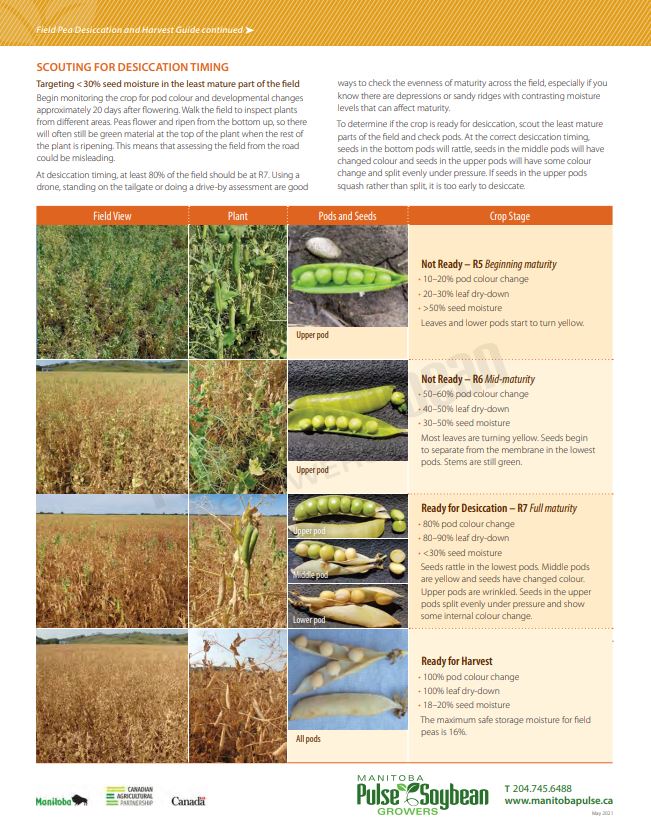
Upcoming Events
- August 3: Keep it Clean Pre-Harvest Tips & Tools Webinar
- August 9: Canada-Manitoba Crop Diversification Centre (CMCDC) Field Day at Carberry.
 Have pulse or soybean agronomy questions this growing season? We’re here to help! Contact Laura (204-751-0538, laura@manitobapulse.ca) or Jennifer (204-751-0737, jennifer@manitobapulse.ca).
Have pulse or soybean agronomy questions this growing season? We’re here to help! Contact Laura (204-751-0538, laura@manitobapulse.ca) or Jennifer (204-751-0737, jennifer@manitobapulse.ca).

